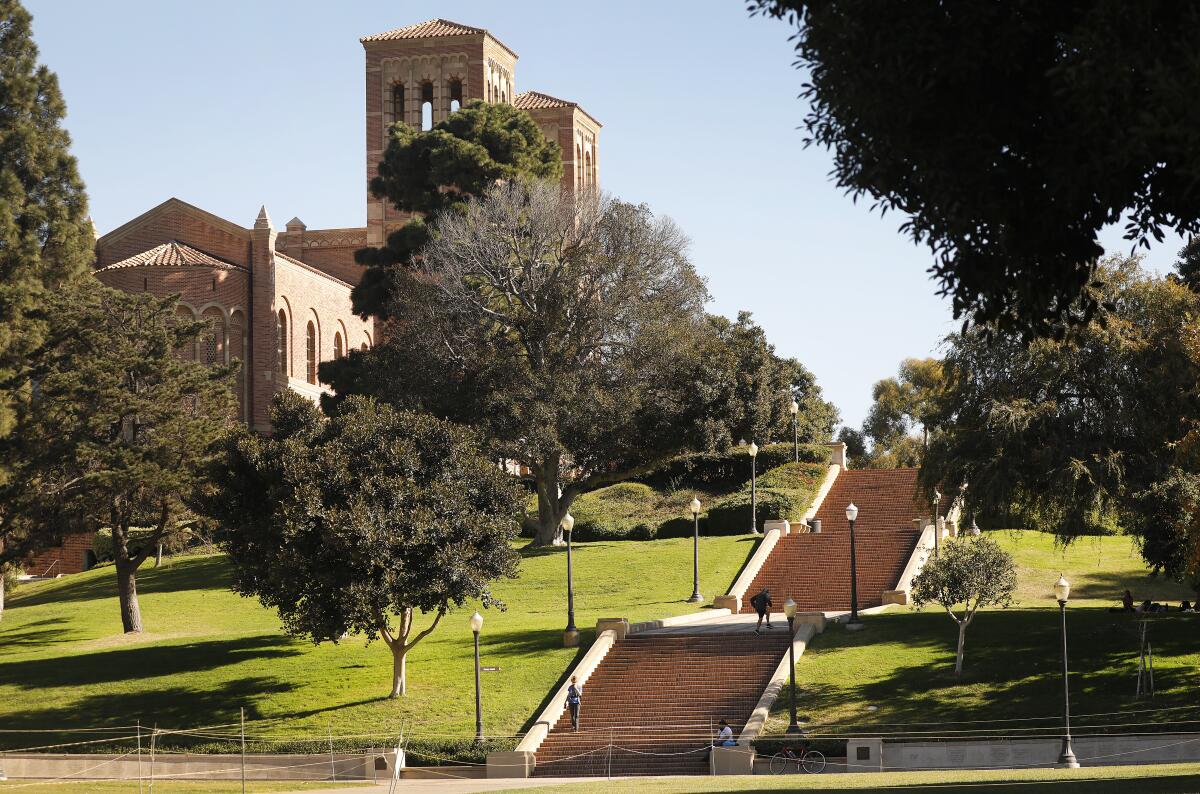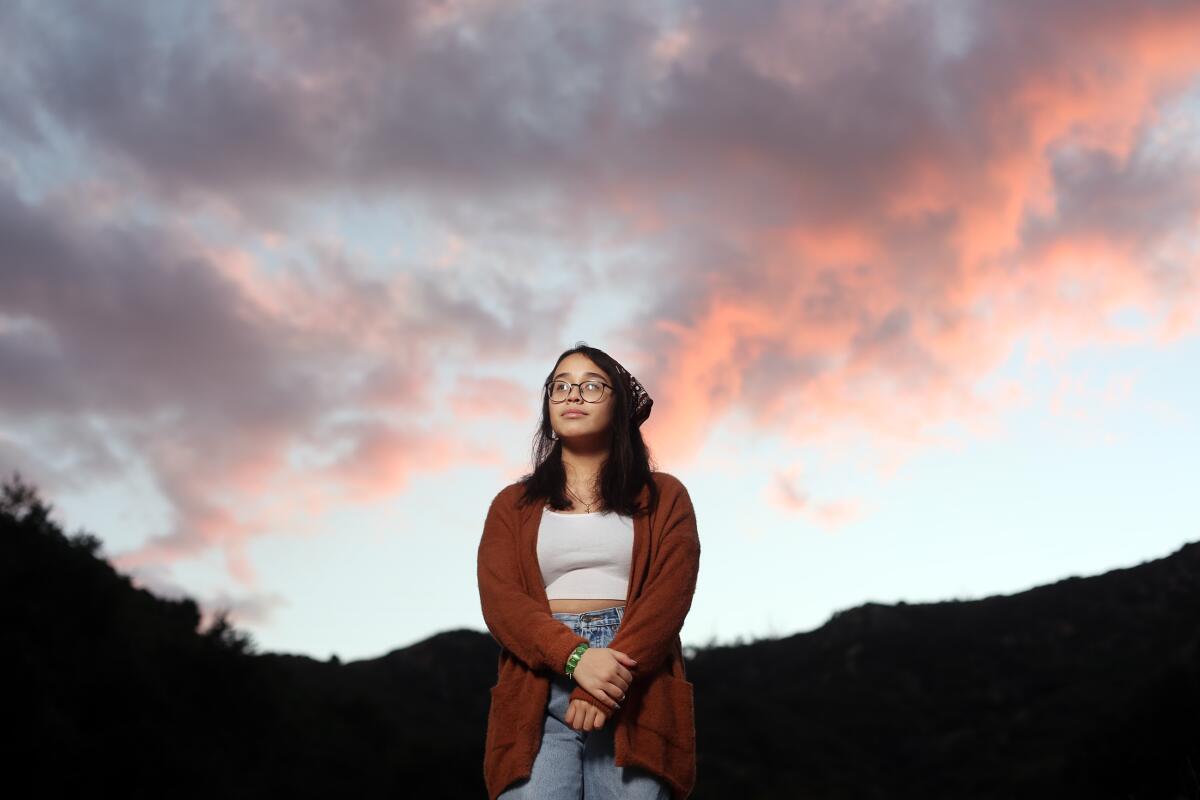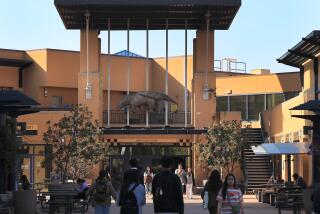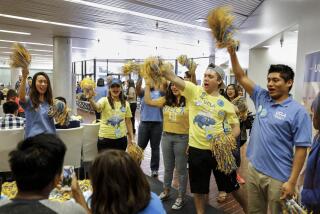UC numbers soar, CSU’s drop as pandemic upends college application season

The coronavirus pandemic has led to a good news, bad news college application season, as the University of California drew a record number of applicants for fall 2021 while California State University tumbled — a disparity reflected nationally by robust growth at many selective institutions and struggles at less resourced ones.
Applications to UC’s nine undergraduate campuses soared to a record 250,000 — a 15% increase over last year, including significant rises among California Latino and Black freshmen applicants, according to preliminary data disclosed by UC President Michael V. Drake in a meeting this week with The Times editorial board. Campus-specific data will not be released until early next year.
“For all the challenges and all of the noise about is [college] worth it, we see more people looking to the University of California as a pathway to their future than ever before,” Drake said.
At Cal State, however, applications declined by 5% with wide variation among the system’s 23 campuses. Cal State Dominguez Hills, which primarily serves disadvantaged students, saw a 17% plunge in applications. But they increased by 4% at Cal Poly San Luis Obispo, the most selective campus with fewer students who are underrepresented minorities, low income or the first in their families to attend college.
So concerned about the disparity, CSU extended its deadline a second time for some campuses.
“The pandemic and the economic crisis have exacerbated inequality,” said Ted Mitchell, president of the American Council on Education, which represents more than 1,700 colleges and universities. “Students with financial resources are turning to selective institutions in record numbers. We have to make sure their less resourced peers join them.”

Admissions experts speculate, however, that two other key factors may be driving application patterns this year. Hundreds of campuses, including UC and Cal State, removed standardized testing requirements this year as the pandemic severely limited the availability of SAT and ACT testing opportunities, encouraging more students to apply to more institutions. And although economic hardship may have discouraged some disadvantaged students from applying to college, it may have led others to seek out universities with generous financial aid, such as the UC system and top private campuses.
The California data mirror national trends. Applications from low-income students and those who are the first in their families to attend college dropped by 7% among the 900-plus private and public campus members of the Common Application, a nonprofit organization.
At the same time, selective private and large public colleges saw applications increase by about 12%, said Common App Chief Executive Jenny Rickard. Applications to less selective private campuses fell by 2% and also declined among small public campuses, which Rickard speculated might be tied to a greater proportion of disadvantaged students at those institutions.
Yale, Emory, Duke, the University of Pennsylvania, University of Virginia and University of Michigan all reported gains in students applying to their early decision programs. USC, which does not offer early decisions, already is seeing an “upward trend” in applications even though the submission deadline is not until Jan. 15, campus spokeswoman Lauren Bartlett said.
Among students themselves, some say the biggest variable in their application decisions this year was not having to submit SAT and ACT scores. More than 600 additional campuses removed those requirements this year because of the pandemic, but UC regents explicitly voted this year to phase out the tests, which they saw as a barrier to equitable admissions.
Andrea Gonzalez, a senior at Alliance Marine Innovation and Technology 6-12 Complex, a charter school in Sun Valley, has a 3.9 GPA, seven AP classes and leadership positions in student government and volleyball. But she was a poor test taker.
“I thought the only thing that would hold me back [on college applications] was my SAT score,” Gonzalez said.
Not having to take the test and submit a score was “a big breath of relief” and gave Gonzalez the courage to apply to some of the more competitive UCs, including UCLA, UC Irvine and UC Santa Barbara.

Gabriela Salazar, a senior at John Marshall High School with a 4.4 GPA, aspires to become an immigration lawyer. Her parents, a self-employed baker and a restaurant worker, both lost work during the pandemic. She couldn’t afford SAT prep classes and she wasn’t happy with her first score. The second test was canceled.
“I felt like all the hard work that I did in high school was to get into a good college — all the all-nighters I pulled and all the times I cried,” she said. “I didn’t want all my hard work to go down the drain.”
She took advantage of SAT-optional offers and submitted applications to seven UCs as well as Stanford, Pepperdine and USC. She also applied to four local CSUs in case they offer her better financial aid.
Cyndy McDonald, a Central Valley independent college counselor, said removing the testing requirement has made a “huge difference” in encouraging high-performing, economically disadvantaged students to aim high, she said.
“Removing those test scores as factors puts them on a much more equal footing,” she said.
Research has found that removing standardized testing requirements increases application rates by up to 10% for the first few years, said Zachary Bleemer, a research associate at the UC Berkeley Center for Studies in Higher Education. That well-known effect led UC admission officers to expect a rise in applications — but those at UC Irvine and UC Santa Cruz said they were startled by the flood that came in shortly after the system began accepting them Nov. 1.
Drake said he was particularly pleased with gains among underrepresented students — a nearly 20% increase in California freshmen applications among Black students and nearly 11% among Latino applicants — which campuses have worked hard to achieve. But admissions officers will be faced with the enormous task of winnowing the flood of applications in a year without test scores, possibly more pass/fails in lieu of letter grades and extracurricular activities disrupted by the pandemic.
“It will definitely be a challenge,” said Emily Engelschall, UC Riverside director of undergraduate admissions. “At the end of the day, the university only gets so many spaces.”
At Cal State, leaders attributed the decline in applications to pandemic-related hardships, which prompted them to extend the original Nov. 30 application deadline to Dec. 15 and again to January or later for several campuses.
The change in volume of applications varied by campus, dropping by as much as 26% among first-time freshmen at Sonoma State and increasing by as much as 9% at Cal Poly Pomona. In part, the numbers reflected some ongoing trends: the recent struggle of several Northern California campuses to attract students from outside their areas because of competition from Southern California, wildfires, limited housing availability and the high cost of housing.
Other high-demand campuses — including San Diego State, Cal Poly Pomona, Cal Poly San Luis Obispo, Long Beach and Fullerton — saw gains or were relatively flat.
But COVID-19 certainly played a role. In L.A. County, one of the counties hit hardest by the pandemic, campuses that serve large numbers of disadvantaged students saw big drops. Applications dropped by 10% at Cal State L.A., where about 60% of students are low-income and about 60% first-generation students. The university serves communities with some of the highest COVID-19 case rates in the county, including East L.A., Florence-Firestone, Pico Rivera, Bell Gardens and Boyle Heights. Applications fell by 15% for first-time freshmen at Cal State Northridge.
Deborah Brandon, Cal State Dominguez Hills associate vice president of enrollment management, said many students live in multi-generational households with family members who either worked in hospitals and restaurants or were recently furloughed or laid off. More than three-quarters of the students are Black and Latino, and nearly the same share are the first in their families to pursue a bachelor’s degree. In 2018, the most recent year for which data are available, nearly 60% received federal financial aid — far greater than the systemwide average of 45%.
Cal State admissions officials said that students had expressed anxiety about finances, including paying the $70 per-campus application fee. They also cited Zoom fatigue, noting that high school students weren’t able to access the same learning or counseling resources as normal, and many were unsure if they wanted to begin college in a potentially virtual environment.
“A lot of students are like, well, do I really want to go to college and do online learning? Or should I just take a gap year and wait until this pandemic settles down and we can actually return to in-person learning and have a “normal” college experience?” said Jose Padilla, a senior enrollment advisor who does recruiting at Sonoma State.
A lot of the university’s high-touch efforts to recruit students were also difficult to replicate remotely. Padilla said that in normal years, he goes to high schools and holds workshops where 60 or 70 students gather in a room and go through the CSU application together.
“This year we did try to do that,” he said, “but when it came to doing it virtually, we would have five to 10 students. ... The last thing they want is to sit in front of a computer and hear another person give a presentation.”
Luoluo Hong, CSU associate vice chancellor for student affairs and enrollment management, said it was “something to celebrate” that the university received as many applications as it did despite the pandemic, recession, and racial unrest this year.
“With that said, I do think we need to be realistic about the challenges our students face,” she said.
More to Read
Start your day right
Sign up for Essential California for news, features and recommendations from the L.A. Times and beyond in your inbox six days a week.
You may occasionally receive promotional content from the Los Angeles Times.








